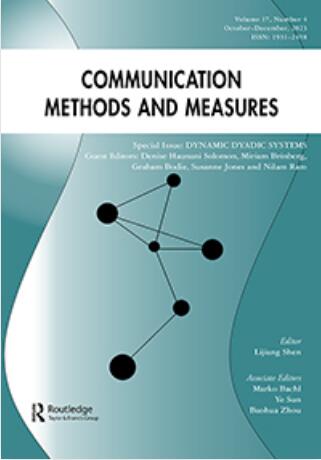The Implications of Communication Technologies for Supportive Conversations: A Dynamic Dyadic Systems Approach Examining Turn Transitions
IF 3.7
1区 文学
Q1 COMMUNICATION
引用次数: 1
Abstract
ABSTRACT Although turn-level dynamics involving the back-and-forth exchange of talk between support seekers and providers form the foundation for supportive conversations, they have largely been overlooked by researchers studying the implications of communication technologies for social support. To address this gap, we demonstrate the utility of examining turn transitions using configural frequency analysis to investigate patterns of talk that mark and distinguish supportive conversations conducted face-to-face and via instant messaging. Using secondary data from two experiments in which the medium for supportive conversations was manipulated among stranger dyads, we explore the nature and prevalence of seeker-to-provider and provider-to-seeker turn transitions. The results demonstrated interpersonal coordination in off-topic talk between seekers and providers that transcended the communication medium. Additionally, patterns were observed suggesting that high levels of provider person centeredness were more likely to be generated and influential in turn transitions appearing in instant messaging compared to face-to-face conversations.通信技术对支持性会话的影响:一种检查转向转换的动态并进系统方法
本文章由计算机程序翻译,如有差异,请以英文原文为准。
求助全文
约1分钟内获得全文
求助全文
来源期刊

Communication Methods and Measures
COMMUNICATION-
CiteScore
21.10
自引率
1.80%
发文量
9
期刊介绍:
Communication Methods and Measures aims to achieve several goals in the field of communication research. Firstly, it aims to bring attention to and showcase developments in both qualitative and quantitative research methodologies to communication scholars. This journal serves as a platform for researchers across the field to discuss and disseminate methodological tools and approaches.
Additionally, Communication Methods and Measures seeks to improve research design and analysis practices by offering suggestions for improvement. It aims to introduce new methods of measurement that are valuable to communication scientists or enhance existing methods. The journal encourages submissions that focus on methods for enhancing research design and theory testing, employing both quantitative and qualitative approaches.
Furthermore, the journal is open to articles devoted to exploring the epistemological aspects relevant to communication research methodologies. It welcomes well-written manuscripts that demonstrate the use of methods and articles that highlight the advantages of lesser-known or newer methods over those traditionally used in communication.
In summary, Communication Methods and Measures strives to advance the field of communication research by showcasing and discussing innovative methodologies, improving research practices, and introducing new measurement methods.
 求助内容:
求助内容: 应助结果提醒方式:
应助结果提醒方式:


